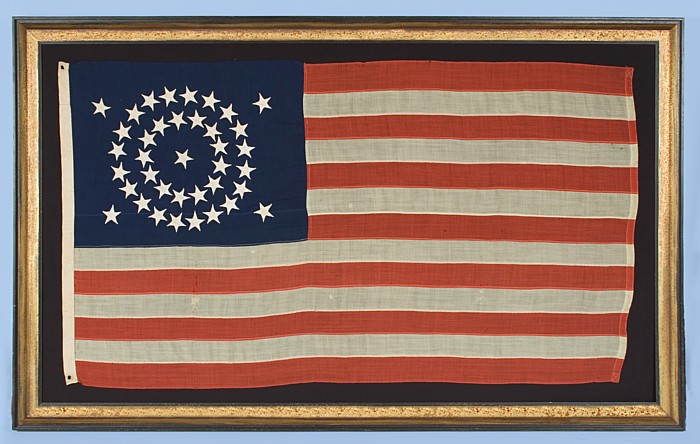
| |
38 STARS, 1876-89, COLORADO STATEHOOD, MEDALLION CONFIGURATION, RARE SMALL SIZE |
|
| Available: |
Sold |
| Frame Size (H x L): |
50.5" x 81" |
| Flag Size (H x L): |
38.75" x 70" |
|
| Description....: |
|
38 STARS, 1876-1889, COLORADO STATEHOOD, MEDALLION CONFIGURATION, RARE SMALL SIZE:
38 star American national flag with a beautiful presentation of a medallion star configuration. This specific style is referred to as a double-wreath pattern, with a center star and four flanking corner stars. The placement of the medallion, in a rather elongated format in the center of the canton, is a bit unusual and adds to the strong graphics of the overall design.
The 38th state, Colorado, joined the Union on August 1st, 1876. This was the year of our nation's centennial of independence from Great Britain. Although 37 was the official star count in 1876, flag-making was a competitive venture and no one wanted to be making 37 star flags when others were making 38's. It is for this reason that 38 and 13 (to reference the original 13 colonies) are the two star counts most often seen during the centennial events.
The 38 star flag was generally used until 1889, when four new states joined the Union. Decorative star patterns, however, like this one, tend to be seen on 38 star flags that were made specifically for 1876 events, such as the Centennial International Exposition in Philadelphia, a six-month long, World's Fair event, held in conjunction with the nation's anniversary.
Despite its appearance, the flag is unusually small for the period. In the 19th century, flags with sewn construction (as opposed to printed) were typically eight feet long or larger. This is because they were very important in their function as signals, which required that they be seen and recognized from a great distance. A small flag was six feet in length and production of flags in this length or smaller was extremely limited. Even infantry battle flags were approximately six by six-and-one-half feet, about the size of an average quilt of the same period. Because the average sewn flag of this era is difficult to frame and display in an indoor setting, many collectors prefer printed parade flags and unusually small sewn flags, like this one.
The stars of the flag are hand-sewn and double-appliqued (meaning that they are applied to both sides). The canton and stripes are made of wool bunting, pieced with a treadle machine. There is a heavy cotton sleeve with two brass grommets. This construction is typical of sewn flags made during this period.
Mounting: The flag has been hand-stitched to 100% silk organza on every seam for support. The flag was then hand-sewn to a 100% cotton background, black in color. The black fabric was washed to remove excess dye. An acid-free agent was added to the wash to further set the dye and the fabric was heat-treated for the same purpose. The mount was then placed in a black painted, hand-gilded and distressed Italian molding. The front is u.v. protective plexiglas.
Condition: Excellent for the period, with minor darning repairs but no significant condition issues. |
|
|
|
| Collector Level: |
Advanced Collectors and the Person with Everything |
|
| Flag Type: |
Sewn flag |
|
| Star Count: |
38 |
|
| Earliest Date of Origin: |
1876 |
|
| Latest Date of Origin: |
1889 |
|
| State/Affiliation: |
Colorado |
|
| War Association: |
1866-1889 Indian Wars |
|
| Price: |
Sold |
|
| |
Views: 3498 |
|
|
|

